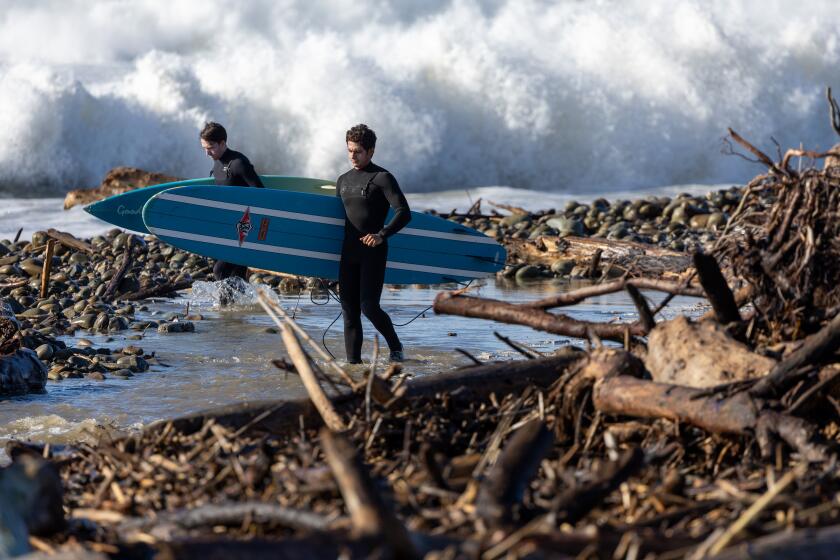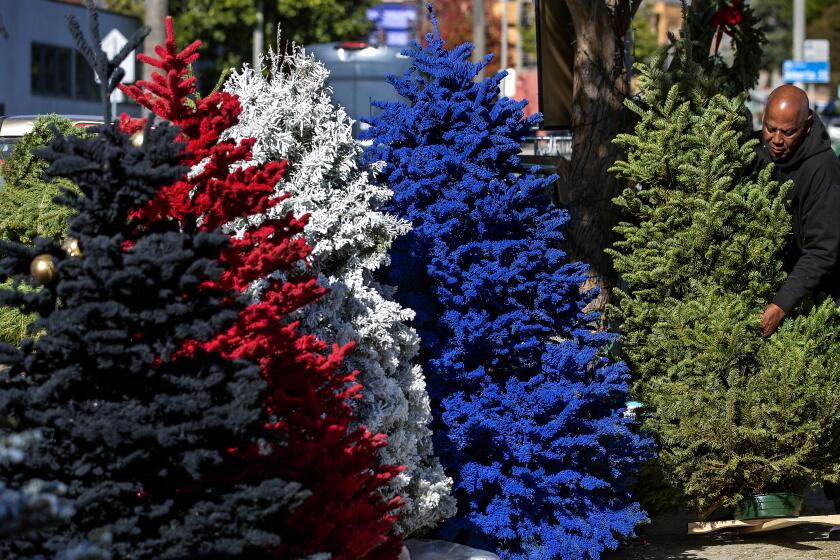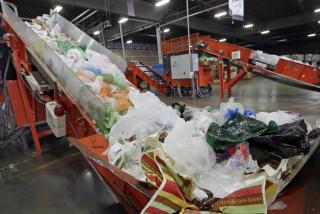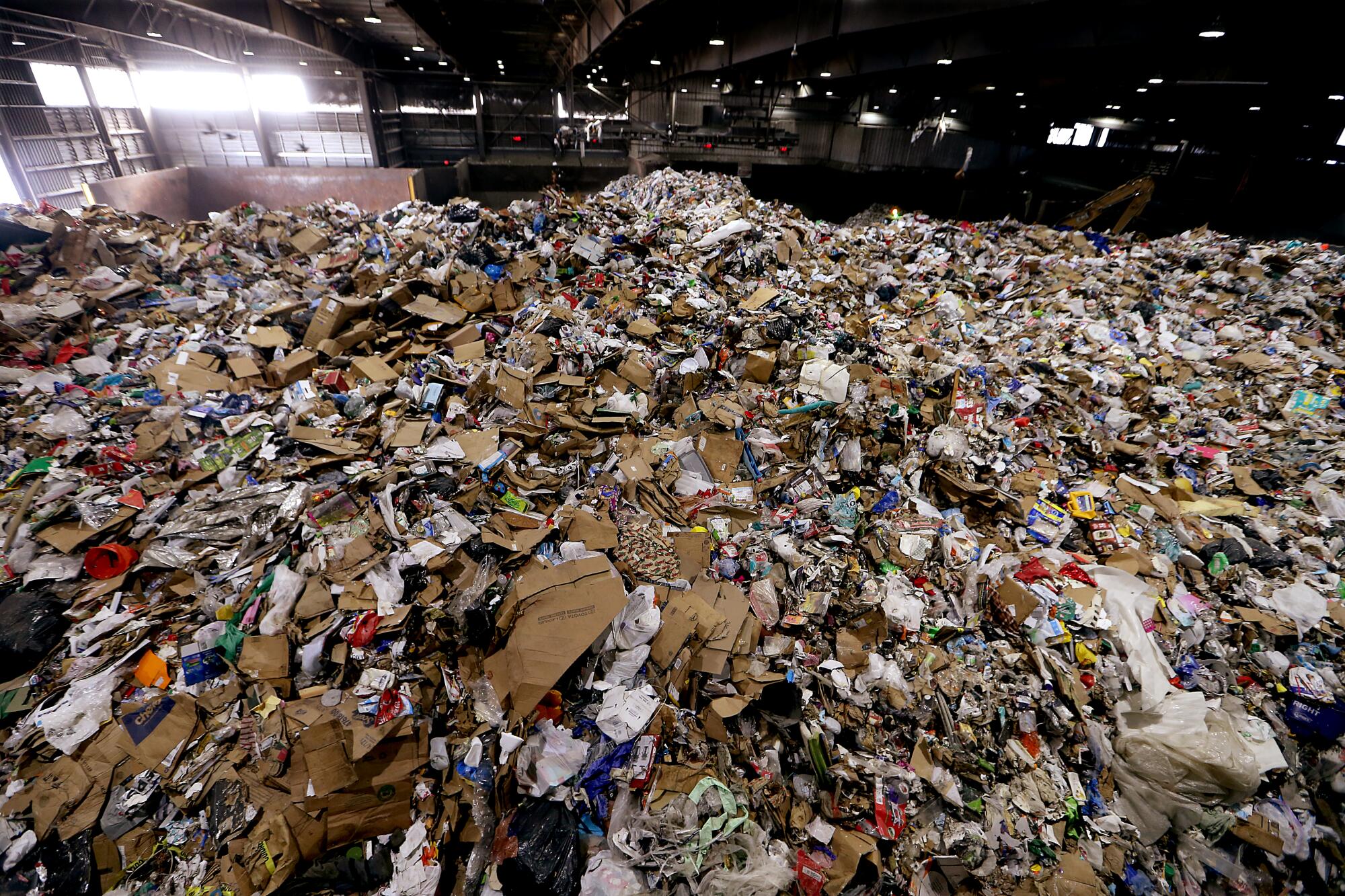
- Share via
‘Twas the week after Christmas, and in a quiet corner of the San Fernando Valley, lines of waste collection trucks waited to offload their goods onto a growing mountain of garbage.
Here at the Athens Materials Recovery Facility in Sun Valley, cardboard boxes careened down conveyor belts, empty bottles and cans flew through crushers and sorters, and hand crews sifted through soggy recyclables.
Wrapping paper, aluminum trays and Amazon logos were a near-constant among the detritus.
“We get a lot more boxes during this time of year for sure,” said Fabiola Martinez, an operations lead with Athens Services, which handles much of the waste hauling and recycling in Los Angeles and other nearby areas.
Aggressive and impactful reporting on climate change, the environment, health and science.
According to waste haulers, managers and researchers, the holiday season provides a visible and tangible surge in trash. In L.A., the buildup is particularly acute after Christmas, when people begin to dispose of heaps of food, wrapping paper and shipping boxes. The city collected 2.04 tons of cardboard in December 2022 compared with 16.42 tons in January 2023, according to data provided by Los Angeles Sanitation & Environment. January also saw 96.78 tons of Christmas trees.
For waste haulers and recycling plant managers across the state, this tidal wave of rubbish brings its own peculiar risks and challenges. For environmentalists, this flood of cardboard and wrapping paper is Exhibit A for why Californians need to lead more sustainable lives, and consume less.
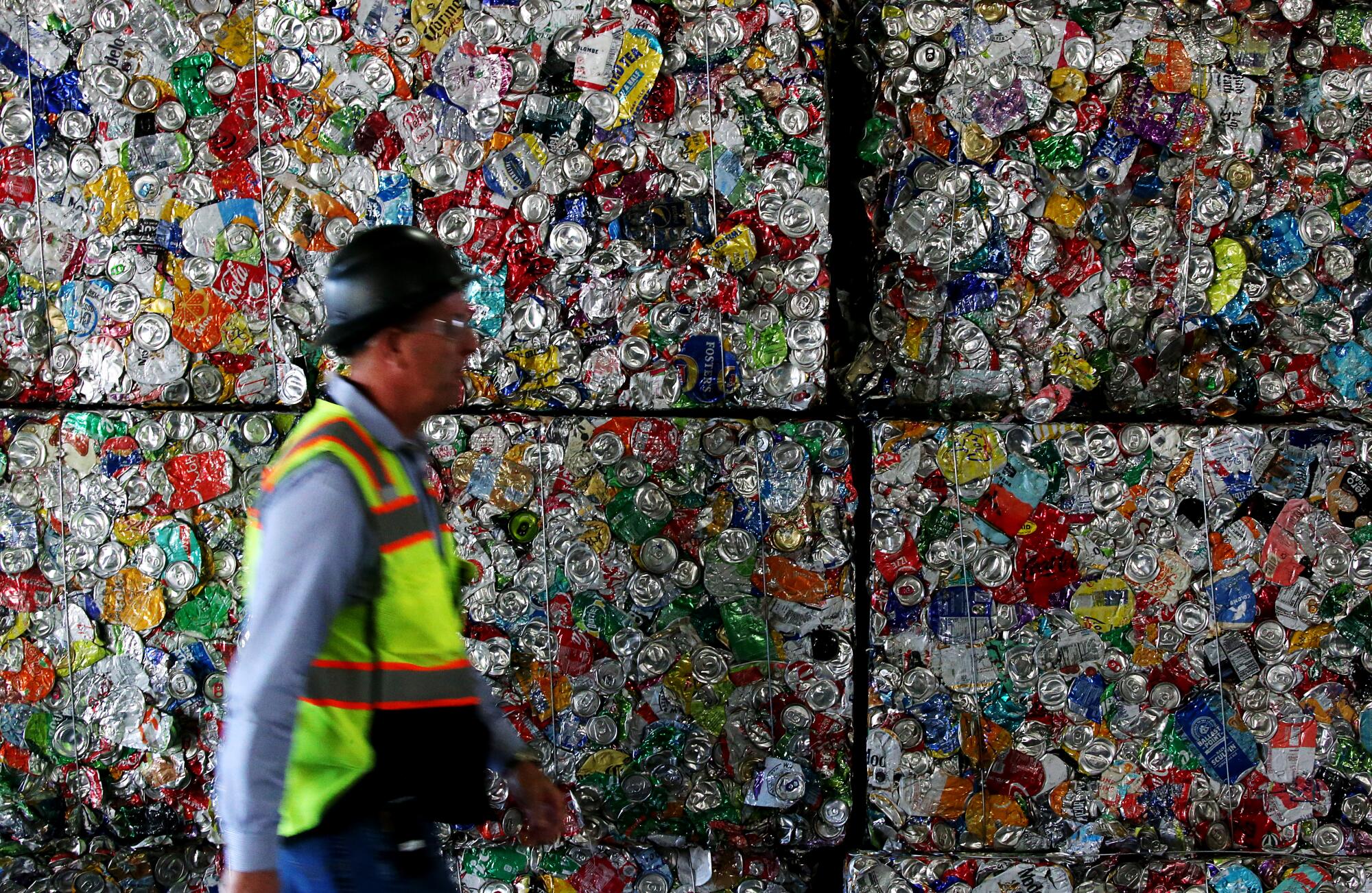
Robert Reed, spokesman for the Bay Area’s largest waste management company, Recology, said waste volume peaks in the three days after Christmas. Although, even in the weeks before and after, increased tonnages are visible at both the company’s recycling and compost facilities.
Same thing in Southern California: The weeks after Christmas and New Year’s Eve are among the busiest of the year, said Riel Johnson, vice president of resource recovery with Athens Services. There are also annual spikes around Labor Day, Memorial Day and the Fourth of July.
But while there is often an increase in the amount of material crews pick up, there is also a shift in its composition around the holidays.
That includes more aluminum and more food waste than normal, largely from holiday gatherings. And then there is the cardboard — or what Johnson refers to as “the Amazon effect.”
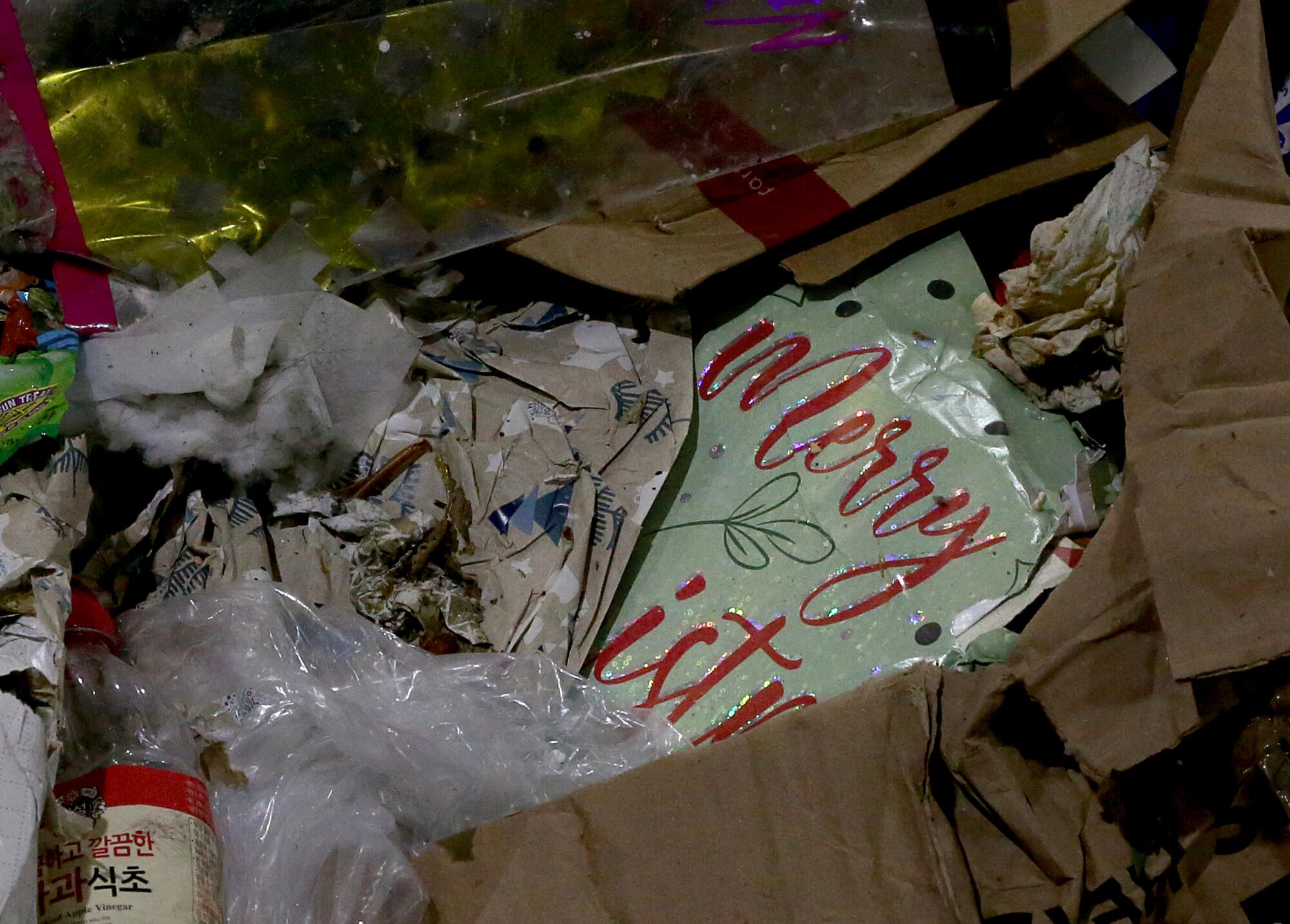
Mountains of the material are constantly moving through the facility, where it gets sorted and packed into massive bales weighing about 1,400 pounds. Johnson pointed to Amazon Prime logos peppered throughout one of the bales. “It’s everywhere,” he said.
Most of it can be recycled, but small cardboard boxes used to ship one-off items often fall through cracks or get stuck between pieces of machinery, he said.
A new rainstorm was expected to move into Southern California on Friday night as residents in some coastal communities dug out from big waves that damaged homes, closed beaches and left several people injured.
Seasonal rainstorms also add to the difficulties experienced by waste haulers and recyclers. Wet wrapping paper and cardboard can be harder for crews to pick up and can jam machinery, requiring equipment to be cleaned more frequently in order to keep things running smoothly.
“Please keep your bins closed,” Johnson said.
Other problematic items include Christmas lights, which can easily wrap around rotating machinery, and batteries, which can cause fires — a major fear in a warehouse full of paper and plastic. Kid’s toys, remote controls and Christmas cards are all hidden sources of batteries and should be disposed of with care, Johnson said.
(If you’re unsure about an item, you can use Athens’ online search guide to look up the best means of disposal.)
And while it may be tempting to toss wrapping paper into your blue bin, many types of wrapping paper aren’t recyclable — especially those coated with plastic and metallics, said Brian Hunter, assistant general manager with Athens Services’ Puente Hills location.

“I love wrapping gifts, but a lot of it has glitter and other things that end up being considered contaminants,” he said, noting that many fiber buyers and paper manufacturers won’t accept the material. Consumers wishing for more eco-friendly products can look for plain paper or sustainable alternatives such as fabric and reusable bags.
The good news is that Christmas trees can generally be recycled so long as they’re placed in green bins and cleared of any lights and ornaments. Hunter said the trees are typically taken to organics facilities to be broken down into chips and “green waste” for reuse.
He encouraged people to “do their best to place the items in the proper container, because obviously it helps out the facility that it’s going to, and also it helps by keeping the people who work here safe as well.”
The Los Angeles Fire Department urges residents to remove and recycle natural Christmas trees, warning that dry needles can turn a small fire into an inferno in less than 7 seconds.
Cheryl Auger, who runs My Zero Waste store in Pasadena — a shop designed to enable consumers to buy products without plastic packaging — suggests we all take a page from Scroogenomics — a book and philosophy written by Joel Waldfogel, an economist at the University of Minnesota’s Carlson School of Management — which touts reducing, or stopping, the over-consumptive nature of Christmas gifts, food and waste.
“I tell people I don’t want presents,” said Auger, who claims to have only received three this season — which she said is still too many. Especially the electronic fly swatter, encased in plastic. “I’m the kind of person who, if I see a fly, I’ll kindly shoo it out the window.”
She said it’s hard for people to abstain from gift-giving and receiving. It’s so ingrained in our culture; the sense of obligation so strong. But if people really thought about the impact they were having — whether it’s the gag gift or toy they know will stick around for an hour before it’s trashed; or the packaging, paper and ribbons on a gift that’s just going into the garbage; or the carbon footprint that followed a present’s packaging, transportation and delivery — they might demur, as well. Or at least think twice about it.

She said she knows people at work roll their eyes and maybe think she’s kind of a wet blanket with all of her hand-wringing about plastic waste. But they’re slowly catching on. One co-worker brought in lunch the other day in a paper bag. “Oh my God, I’m so proud because she wouldn’t have done that like even a month ago.”
As for gifts — she knows she won’t be able to stop the consumerism that comes with the holiday season — so, she suggests people wrap presents in items around the house or work that they don’t use or need. For instance, Auger owns a rental property. After the tenants moved out, they left some items behind — including a bag for a blow dryer.
“It was plastic and just going to be tossed,” she said. But, it fit the gift she was wrapping and gave the item a second life.
She said newspaper sleeves, newspaper and packaging paper can also be used for wrapping. She said her newspapers often arrive in green or blue plastic sleeves, which make nice decorative bows for Christmas and Hanukkah gifts.
And gift cards! Don’t even talk to her about those plastic cards that most people forget to use and end up in landfill.
“Give cash!” she said. “It’ll get used and it makes people happy.”
In Manhattan, you won’t find a tree farm or Home Depot parking lot pop-up; many New Yorkers sidewalk-shop for their Christmas trees, buying from vendors who fill the streets each December.
Reed, the Bay Area waste management spokesman, shared photos of the gargantuan piles of waste sitting in the company’s San Francisco site. He said while these holiday spikes are predictable, they also track economic activity.
“When the economy is good, residents and businesses produce more refuse,” he said.
Like the others, he urged consumers and holiday revelers to reduce, reuse and pay attention to the materials they are buying. Can they be reused? Recycled? Composted? Or are you purchasing an item, wrapping, bag or bow that will be used once, then sent off to a landfill where it will sit, undisturbed, for the next several millenniums?
He urged people to use canvas or other reusable materials to bag their groceries, carry metal water bottles to avoid plastic bottles, and bring refillable coffee mugs to their favorite coffee shops. Like Auger, he said such items make great gifts, too.
He also suggested people try to get to their local farmers markets, where “produce is presented on tables, not plastic.”
Reed quoted studies that estimate 9 million to 11 million tons of plastic enter our oceans each year, and that plastic in the environment will double by 2030 and nearly triple by 2040. His company urges people to opt for no-packaging alternatives when shopping and to “favor non-plastic options” when packaging is necessary.
“Here’s the bottom line on plastic,” he said. “If we don’t buy it, they won’t make it.”
Johnson, of Athens, noted that not all neighborhoods are created equal when it comes to recycling, and that demographics can make a difference. Wealthy L.A. neighborhoods often fail to put the correct items into the correct bins, he said, while residents of multi-family housing tend to run out of bin space.
“There is always room for improvement, but in general, L.A. does a good job,” he said. “I think Californians — and Angelenos — want to do the right thing.”

